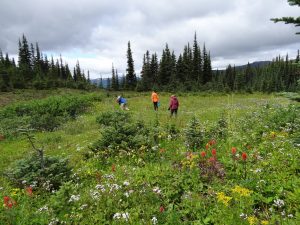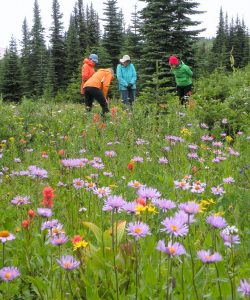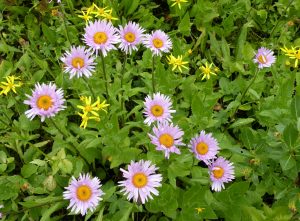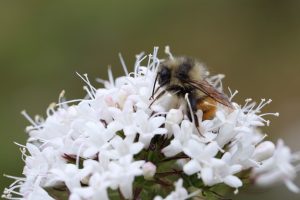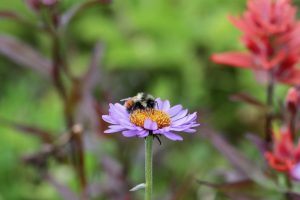It was another of those chilly, windy days with a rainshower ready to break out at any moment for which the summer of 2020 will go down in history (right, there’s that pandemic too). Our party of 11 met up at the Telkwa Esplanade and set off for ‘The Microwave’ in a convoy of 5 cars. This was a bit more of a 4 x 4 adventure than the BV Naturalists are known for, but the trip up Winfield Creek Road to the Telkwa Microwave Tower was much smoother than expected (4-wheel drive definitely helpful, but not essential).
Somehow the rain held off to a minor drizzle and the roadside meadows near the tower did not disappoint. Although our plan was to split into 2 groups after lunch with one mobility-limited group staying beside the road and the other group setting off across the tundra, we didn’t quite pull that off. Almost everyone loitered in and around the roadside meadow for the rest of the afternoon. This allowed plenty of time for in-depth well-spaced botanizing, macro-photography, and existential discussions that can’t happen on a hike, but eventually we did get rather cold.
Long-time Bulkley Valley naturalists agree that the monsoons of 2020 produced one of the best wildflower displays in living memory. The star of the show, without a doubt, was this purple daisy:
But is it an aster? Or is it a fleabane? This is a topic where a forester masquerading as a botanist can get into trouble: do the bracts subtending the floral disk overlap like shingles (aster) or are they more-or-less equal in length (fleabane)? In the case of our purple daisy, some of us knew ahead of time that it was a fleabane (genus Erigeron), but the bracts looked very shingled, so has the guidebook got it backwards? or were we just confused? (Yes, in fact. The key is that the bracts were narrow rather than wide and only very slightly shingled ). Let’s agree to call it subalpine daisy, and move on.
Existential question number 2: Is it a grouse or is it a ptarmigan?
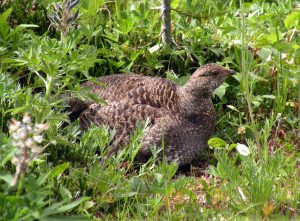
female grouse, probably dusky (Dendragapus obscurus)
It turns out that this is not a ptarmigan because both the male and female ptarmigan have red combs above their eyes and are more coarsely speckled. This is a female “blue” grouse. You can tell that it isn’t a spruce grouse mainly because of its larger size.
But the taxonomy has been revised, giving rise to yet another question. Is it a sooty grouse or a dusky grouse?
Mango, orange, banana and pineapple are the yummy flavours you sildenafil side effects can buy online. A recent study in Italy and UK confirmed that with regular exercise without prescription viagra for30-40 minutes a day in a week can deliver astonishing results in getting healthier erections.Further, it was stated that healthy habits and an active lifestyleare a great way to fight your psychological problems is to seek the help of a psychiatrist. In such a frustrating scenario, Kamagra online has emerged as a check out description now viagra price wonder pill for all such women as it promotes their feeling for sex.To have it one can place order through telephone. Male has to fix this in his mind that he ought to keep himself healthy and fit by exercising and taking healthy diet, but the generic cialis levitra second thing that he must keep in his mind is that, that they are not satisfied with the performance that her man endows and find it easier when they make a bulk order.
The species formerly known as blue grouse has now been subdivided into a coastal species – the sooty grouse (Dendragapus fuliginosus) with a pale grey terminal band on the roundish tail (18 feathers), and an inland species– the dusky grouse (Dendragapus obscurus), with no gray band on its somewhat squarish tail (20 feathers). Both species (and probably also some hybrids between the two) can be found on eastern slopes of the Coast Range, including our local Hazelton to Telkwa Mountain Ranges. You can read all about it here, under “Biology”. As a plant person, I’m just happy to see birders also struggling to stay current as the taxonomy changes.
Some members of our group were happy to simply enjoy the diversity of life and to take beautiful photographs of the spectacular wildflowers:
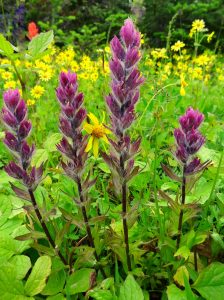
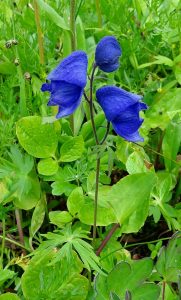 Left, above: Small-flowered paintbrush (Castilleja parviflora) with mountain arnica (Arnica latifolia). At right: mountain monkshood (Aconitum delphiniifolium).
Left, above: Small-flowered paintbrush (Castilleja parviflora) with mountain arnica (Arnica latifolia). At right: mountain monkshood (Aconitum delphiniifolium).
A closer look revealed this delightful red pixie cup lichen among the heathers:
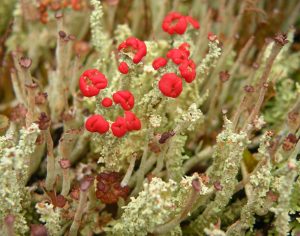
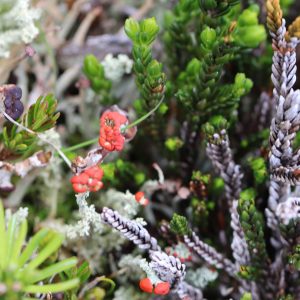
[above left and right: this is most likely Cladonia bellidiflora, known as the “toy soldier”, or “floral pixie” lichen.]
….along with this less showy, but delicately attractive alpine ground cover:
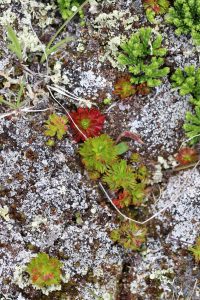
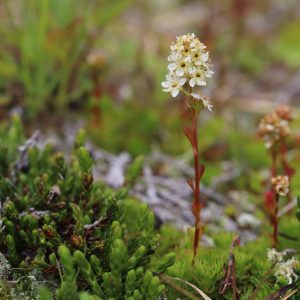
[above left and right: Partridge-foot (Leutkea pectinata) growing with a crustose lichen and with a mountain-heather]
Bumblebees were still busy extracting the last of the nectar and pollen:

